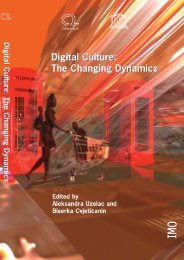free download in pdf format - Culturelink Network
free download in pdf format - Culturelink Network
free download in pdf format - Culturelink Network
Create successful ePaper yourself
Turn your PDF publications into a flip-book with our unique Google optimized e-Paper software.
Perform<strong>in</strong>g identities - national theatres and the re-construction of identities <strong>in</strong> Slovenia and the SFRY<br />
Up until 1954 as many as 18 new national theatres were established all over Yugoslavia:<br />
8 <strong>in</strong> Serbia (of which 4 <strong>in</strong> Vojvod<strong>in</strong>a and 1 <strong>in</strong> Kosovo), 7 <strong>in</strong> Macedonia, 2 <strong>in</strong> Croatia and<br />
1 <strong>in</strong> Montenegro. At that time the total number of professional theatre companies <strong>in</strong><br />
Yugoslavia was 59 (<strong>in</strong>clud<strong>in</strong>g 5 companies with semi-professional status). 7 Th e number of<br />
national theatres was constantly <strong>in</strong>creas<strong>in</strong>g and <strong>in</strong> 1990 there were as many as 35 national<br />
theatres <strong>in</strong> the former Yugoslavia. 8 Th is trend of establish<strong>in</strong>g new national theatres<br />
persists even <strong>in</strong> the 21st century. For <strong>in</strong>stance, <strong>in</strong> the Slovenian city Nova Gorica, the<br />
theatre previously known as Primorsko dramsko gledališče (Primorska Drama Th eatre) 9<br />
was renamed the Slovensko narodno gledališče Nova Gorica (Slovenian National Th eatre<br />
Nova Gorica) <strong>in</strong> 2003. 10 It is signifi cant that this symbolic shift of the theatre <strong>in</strong> Nova<br />
Gorica from one among many regional theatres to third Slovenian national theatre (and,<br />
nota bene, the fi rst new national theatre <strong>in</strong> Slovenia s<strong>in</strong>ce 1918) occurred only half a year<br />
before Slovenia entered the European Union and the border between Slovenia and Italy<br />
was symbolically removed precisely between Nova Gorica (Slovenia) and Gorizia (Italy). 11<br />
Slovenian national theatre aft er 1991<br />
In the years preced<strong>in</strong>g the collapse of federal Yugoslavia, and for various reasons, the<br />
prevail<strong>in</strong>g political atmosphere <strong>in</strong> Slovenia pulled the country away from the community of<br />
Yugoslav nations. Political and cultural elites, especially their most extreme nationalist parts,<br />
stimulated secessionist tendencies. Th e soil was prepared and fertile, thanks to Milošević’s<br />
extremely aggressive nationalism and to the controversial role played by the federal army. At<br />
a certa<strong>in</strong> moment, even the economic sphere started to behave <strong>in</strong> the manner of “national<br />
economies”, preach<strong>in</strong>g “national <strong>in</strong>terests” and <strong>in</strong>troduc<strong>in</strong>g protectionism <strong>in</strong> trad<strong>in</strong>g with<br />
companies from other federal republics. As a consequence of radicalization of <strong>in</strong>ter-republic<br />
relations at the political and economic level, national and cultural stereotypes gradually<br />
penetrated the public sphere. Th e shift away from south-Slavic culture is traceable <strong>in</strong> “hard<br />
data”, as clearly demonstrated by Slovenian theatre historiographer Barbara Sušec Michieli:<br />
7 It is worth mention<strong>in</strong>g that <strong>in</strong> the late 1950s/early 1960s <strong>in</strong> Yugoslavia for every 280,000<br />
<strong>in</strong>habitants there was one professional theatre company; the same ratio <strong>in</strong> the USSR was<br />
1:400,000 and <strong>in</strong> the USA 1:850,000 (Kalan, 1962: 3).<br />
8 At that time 90 permanent theatres were offi cially registered <strong>in</strong> Yugoslavia. It means that<br />
almost one third of all professional theatres had <strong>in</strong> their names the word “national’.<br />
9 Primorska is one of the regions <strong>in</strong> Slovenia.<br />
10 In the last two decades (i.e. <strong>in</strong> the fi rst 20 years of Slovenia as a sovereign country), three<br />
new municipal theatres were established: <strong>in</strong> Ptuj, Koper and Novo Mesto. Several commercial<br />
theatres were also opened towards the end of the 1990s.<br />
11 Th e Paris Peace Treaty created a new border between SFR Yugoslavia and Italy, leav<strong>in</strong>g Gorica<br />
(Gorizia), the traditional regional centre of the Soča and Vipava Valleys, outside the borders<br />
of Yugoslavia. Due to these geo-political reasons, a completely new town called Nova Gorica<br />
(New Gorizia) was built on the Slovenian (Yugoslav) side of the border aft er 1948.<br />
53



